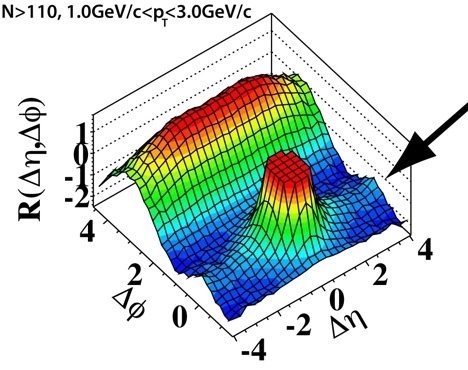A surprise from the LHC
There was a special Cern seminar yesterday evening on some new results from the CMS experiment, one of the detectors at the Large Hadron Collider. The result is summarised in this colourful landscape.
 Particle correlations in the CMS detector at the LHC First imagine this is a contour map of the cylinder CMS makes around the LHC collisions. It has been cut lengthwise and unrolled. Then for each pair of particles in an event, you put one of them at (0,0), and plot the position of the other. (Thanks to GreyBadger for the comment below correcting the initial over-simplified explanation here).
Particle correlations in the CMS detector at the LHC First imagine this is a contour map of the cylinder CMS makes around the LHC collisions. It has been cut lengthwise and unrolled. Then for each pair of particles in an event, you put one of them at (0,0), and plot the position of the other. (Thanks to GreyBadger for the comment below correcting the initial over-simplified explanation here).
The map is the average distribution of the separation between particle pairs for a very special class of events, with very many particles in them. The big peak is something like a "jet" of particles, what we expect when a quark or gluon in the proton undergoes a collision and is scattered off at an angle.
Balancing it on the other side is a long ridge. This is an expected feature. You have to have something there to balance energy and momentum.
The weird thing is the other ridge. This shows particles and energy coming out far away from the jet in rapidity but on the same side of it around the cylinder. Our best models of quark and gluon interactions and jet production do not predict such an effect.
What is causing it? Well, a similar effect was seen at the Relativistic Heavy Ion Collider (RHIC) in the US. There it was interpreted as the quarks and gluons in a collision between heavy nuclei behaving collectively - moving together like a drop of liquid or a plasma. This is the way quarks and gluons behave under extreme temperature and pressure - for instance shortly after the Big Bang.
The big surprise is seeing these in proton-proton collisions. As far as I know, it was thought that the temperature, pressure and the sheer number of quarks and gluons would not be enough to cause this. This is why RHIC uses heavy nuclei, not just protons.
The LHC will run with heavy ions at some point soon. My guess is that the CMS scientists were making this measurement with protons as a baseline test for future heavy ion measurements. I suspect they are as surprised as anyone else to see that ridge.
 RSS Feed
RSS Feed Twitter
Twitter
0 Response to "A surprise from the LHC"
Post a Comment
Submit what you know about games.It will be published in
this site